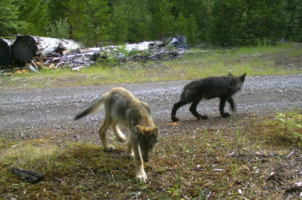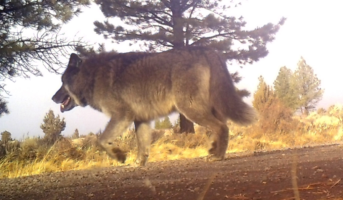
Remote camera photo taken in western Lake County of an adult wolf using the same area as OR28 (photo by ODFW, Dec. 2015).
by Nick Cady, Legal Director
On June 7, the Oregon Fish and Wildlife Commission, whose members are appointed by Governor Kate Brown, adopted revisions to the state’s Wolf Conservation and Management Plan. This plan is required to be updated every five years, but this latest update was over four years late given the Department of Fish and Wildlife’s (ODFW) efforts to remove wolves from the state list of threatened and endangered species. Although wolves in Oregon are slowly recovering from their extirpation in the 1940s, the updates to the plan dramatically increase the situations in which wolves can be killed both by ODFW and members of the public.
The weakening of these protections could not come at a worse time because the US Fish and Wildlife Service is proposing to remove wolves from the federal list of endangered species. These federal protections have ensured that recovering wolves in the western two-thirds of Oregon are not killed by ODFW or other agencies and have facilitated the dispersal of wolves into California and Washington. A decision has not yet been made by the US Fish and Wildlife Service and a public comment period remains open. You can comment until July 15 to urge the Service to maintain federal wolf protections. * This comment period is now closed *
This issue has rightfully received extensive media attention, with the Oregonian, the Statesman Journal, OPB, and others all reporting on the topic. Governor Kate Brown, despite the fact that the Fish and Wildlife Commissioners serve at her behest, criticized the plan for not meeting its “conservation-focused mission.”
While there has been a lot of buzz, a dive into the provisions of the actual plan is necessary to understand its full import. The latest Oregon Wolf Conservation and Management plan can be found here in full, but below are a summary and critique of some of the major provisions.
Oregon Wolf Conservation and Management Plan Details
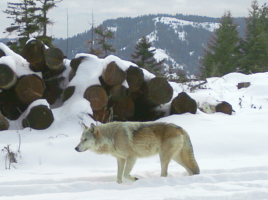
The breeding female of the Walla Walla Pack captured on a remote camera on private property in northern Umatilla County (photo by ODFW, Dec. 2017).
While Oregon’s Wolf Plan contains a certain amount of basic wolf biology and monitoring techniques, its primary focus is on when and how wolves can be killed. This is no doubt an important issue for consideration given that wolves were eradicated from the lower 48 by human hunting, trapping, and poisoning. But instead of adopting strong restrictions to protect wolves from experiencing the same fate, the plan seemingly details every conceivable way in which a wolf might interfere with a commercial livestock production or hunting tag sales, and permits wolves to be killed in each of those situations.
Wolf-Livestock Conflict
Wolves are an insignificant factor in livestock deaths in the United States. Wolves kill .009 percent of cattle in this country pursuant to numbers reported by the Department of Agriculture. The most recent data published by the US Department of Agriculture-Animal and Plant Health Inspection Service (USDA) indicate losses many times greater than those collected by states and the US Fish and Wildlife Service (FWS). In the Northern Rocky Mountains, for instance, the USDA claims wolves killed 4,360 cattle in 2015, while the FWS verified only 161 such losses. Most cattle die from health-related maladies, weather events or theft. Simply put, wolves do not kill many sheep or cows, however, these conflicts are the primary focus of Oregon’s wolf plan.
The Wolf Plan allows the killing of wolves in response to “chronic depredation,” and this one of the most important concepts in the update. Killing wolves in response to chronic depredation has accounted for the vast majority of human-caused wolf mortality in our state. The plan now defines chronic depredation as any two depredations (or conflict between wolves and livestock) within a nine-month period. If this standard was applied over the previous few years, the majority of Oregon’s wolf population would have been killed by the Department. Pursuant to the Department’s own analysis that accompanied its removal of wolves from Oregon’s endangered species list, the loss of just a handful of wolves each year from human-caused events will risk species extinction in the state.
Thus, implementation of this provision will be a critical factor in whether wolf recovery in Oregon proves a success or a failure. Unfortunately, by setting such a low bar, the Department creates an expectation from the industry that every time a cow or two is killed or even simply injured by wolves, wolves should be killed in response. The most frustrating part of this approach is that killing wolves in response to livestock loss has not decreased depredations and in some cases has increased depredation rates. Killing wolves can disrupt a pack’s social dynamics and can force a pack to risk closer proximity to humans to secure food.
In summary, the Department will be killing wolves at the behest of the commercial livestock industry to address wolf-livestock depredations even though this approach is costly and has proven ineffective where studied. The killing will rely upon public dollars and compromise ongoing wolf recovery in the state. It is important to keep in mind that there are a minimum of 137 confirmed wolves in Oregon and over 1.3-million cattle.
Compensation
In addition to killing wolves to subsidize the commercial livestock industry in Oregon, these producers are also compensated with Oregonians’ tax dollars for the livestock losses. The Oregon Department of Agriculture compensates livestock producers at full market-value rates for any losses even loosely related to wolves. These compensation allocations have never been exceeded demonstrating that wolves are again not a significant factor in losses and that there is no need to kill wolves to reduce depredation rates because they simply are so low. This compensation program has also been rife with fraud, but no steps have been taken to address the problem. So not only are wolves killed in response to the these livestock losses, but the livestock producers are also compensated under a heavily abused system.
Controlled Take
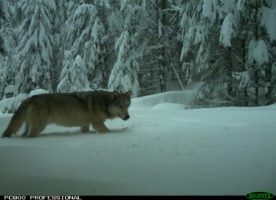
Three different wolves from the Indigo group were seen on a remote camera, Feb. 20, 2019 in the Umpqua National Forest (photos courtesy of USFWS).
The Wolf Plan now permits “controlled take,” which would constitute “responsive hunting and trapping when required for management purposes, although these management tools would not be applied in the same manner as under a traditional game mammal or furbearer classification.” So while not structured as a traditional hunting season, the plan authorizes the hunting of wolves. Pursuant to recent polling, hunting of wolves goes against the wishes of the majority of Oregonians, the people that the Fish and Wildlife Commission serves. Also, public killing of wolves would hinder if not undue recovery given the overall low numbers of wolves in the state coupled with fragile dispersal situations further west and south.
According to the Plan, the Department will now allow the use of “public/private hunters and trappers… to assist with ODFW management response actions.” The use of public hunters/trappers in this manner entails huge risks for the Department. Repeatedly, we have seen agency personnel — life-long professionals — shoot the wrong wolves or shoot breeding pair members when they were not supposed to be targeted, and the accidental trapping and poisoning of wolves. We have even seen wolves die when the Department was simply trying to dart and collar these animals. There is simply too much at stake to risk members of the public with these sensitive tasks.
Also there are no suggestions in the Plan for how to hold members of the public accountable if this controlled take authority is misused either mistakenly or intentionally. The Department on the other hand has built in accountability structures and public processes that ensure proper action. There is no question that implementation of this “controlled take” provision will result in conflict and disaster. Public shooting and trapping of the wolves is inappropriate and has no place in Oregon.
Killing Wolves in Response to Deer and Elk Decline
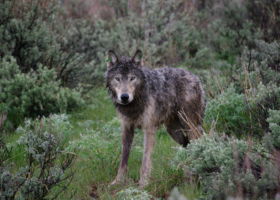
Oregon’s first radio-collared wolf, an 87-pound male estimated to be about 2-years-old, just after its release, with ear tags and a radio collar (photo by ODFW, May 2009).
The Wolf Plan authorizes the killing of wolves in response to declining deer and elk numbers. However, the Department updated the science section in the new plan, and within that, concludes that wolves will not have an impact on deer and elk numbers. The science section concludes that “a complex suite of abiotic, bottom-up, and top-down forces including hunter harvest, predation, primary productivity, and climatic conditions that may be limiting or regulating factors of ungulate population dynamics (Crête 1999, Melis et al. 2009, Griffin et al. 2011, Brodie et al. 2013, Johnson et al. 2013).”
The review of the science and the direct experience of the Department in Oregon “suggests that wolf predation on [elk] is largely compensatory (Garrott et al. 2009) and will have minimal effects on elk population growth rates.” “Compensatory” means that any wolf kills largely replace kills or mortality that would have occurred from other factors. The plan states that some scientists have suggested that wolf behavior could affect ungulate migration patterns and behavior, but “little research has linked the anti-predator behaviors… to reduced fitness and/or reproductive output of ungulates (Lind and Cresswell 2005).”
There were two important findings in this science review: that ungulate populations are largely regulated by habitat and climate, and that wolf predation is largely compensatory — they are killing animals that would be lost by other causes regardless. The plan also takes a thorough look at the evidence in this state and neighboring states with wolves, and all the evidence gathered by these agencies suggests that wolves are not having a measurable impact on ungulate populations.
The 2005 Wolf Plan had initially included a provision to allow for killing wolves in response to wolf-ungulate problems, but it was very limited to localized and specific problems. The original language of the Wolf Plan stated that: “When predation is determined to be the primary cause of ungulate population or recruitment decline locally or in a WMU, ensure carnivore-focused management actions… If wolves are determined to be the cause of ungulate population or recruitment decline… use translocation, relocation or controlled take to reduce wolf numbers.” This was a two-step determination, requiring the Department to establish that carnivores were indeed the primary cause of the decline prior to initiating killing of wolves in response. This was a precautionary, science-based approach that erred on the side of not spending resources on killing until the Department was confident it would address the problem. The original Wolf Plan discusses a specific situation in Canada where a small population of Caribou, only 20 individuals remaining, were being targeted by a single wolf pack, and this would be the type of situation where this controlled take provision would be used.
Despite soundly rejecting its scientific basis, the plan now authorizes ODFW to kill wolves to address ungulate decline “if ODFW determines that wolves are a major cause of the population not meeting established ungulate objectives or herd management goals in a WMU, active management (e.g., non-lethal methods or lethal removal) of wolves may be used.” Draft Wolf Plan at 73. Putting aside the fact that this far looser language directly conflicts with the science section, this proposed new language is problematic for two additional reasons. First, a “major cause” is vague and gives the agency far more discretion. ODFW was specifically asked why this standard was relaxed, and the Department explained that it could not scientifically establish a link between wolves and ungulate decline, so they relaxed the standard. This is wildly inappropriate. If a link cannot be established, it is because wolves are not causing the decline or are not a significant factor in the decline, and thus we should not be killing to address this problem because it will not work.
Any time there is ungulate decline in wolf territory, there will be loud voices arguing that wolves need to be hunted. Likewise, conservation groups will argue that wolves are not a “major factor.” This vague language will lead to conflict. It sets the stage for poor, politically-motivated decisions that will only serve to create more conflict. Secondly, it will call into question and invite more scrutiny of the Department’s ungulate objectives, which are arbitrary and not rooted in historical data.
Wildlife Services
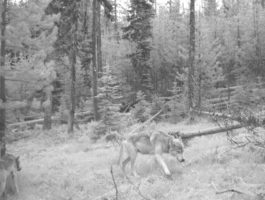
From left, a two-year-old male and the alpha female of the Imnaha pack. Image captured on trail camera in Wallowa Whitman National Forest, Wallowa County (photo by ODFW, June 2011).
The plan allows ill-named Wildlife Services to conduct livestock depredation investigations in order to determine whether or not wolves were involved. These are very important determinations because the Department’s chronic depredation determinations and ultimate decisions to kill wolves in Oregon are based upon the results of these investigations. Thus far, ODFW, has been very cautious about concluding wolf involvement in depredations and has approached this issue with diligence and integrity.
Wildlife Services lacks integrity, lacks public trust and its involvement in these depredation investigations will undermine all confidence in future determinations. This agency has a proven track record in Oregon of blaming wolves when wolves were not responsible, and for this reason, this agency was removed from its role in investigations in 2010.
There have been so many instances of animal abuse, the poisoning of people and pets, egregious mistakes like the killing of the wrong wolves, but even putting this aside, this agency has a proven track record of grossly overestimating when wolves have been involved in depredations here in Oregon. The involvement of Wildlife Services in depredation investigations in Oregon will wrongfully inflate wolf depredation numbers and only serve to further conflict around the issue instead of developing meaningful solutions.
The Future of Oregon’s Wolves
Wolves are incredibly important to Cascadia Wildlands and our members, supporters, and volunteers. So much time and energy has been poured into the recovery of this species, and our organization and staff cannot express enough thanks for your overwhelming demonstration of support and dedication. Simply put, this would not work without you. And while this Wolf Plan is a disappointment to say the least, this has always been an uphill struggle. A struggle against systems designed to service a commercial industry and cater to hunting groups. This Wolf Plan is not the result of a failure of our efforts, but one small step along the path to reform wildlife management in the Pacific Northwest and bring science and public values to the forefront of Oregon’s Fish and Wildlife Commission. The new Wolf Plan will require heightened vigilance and will certainly amount to some setbacks, but it opens new avenues for reform, new avenues that could prove much more successful. We ask for your continued support on this front because this struggle is not limited to a single Wolf Plan or even a single species, but involves a completely new perspective and approach to wildlife management in the West. We will get there with your help.


